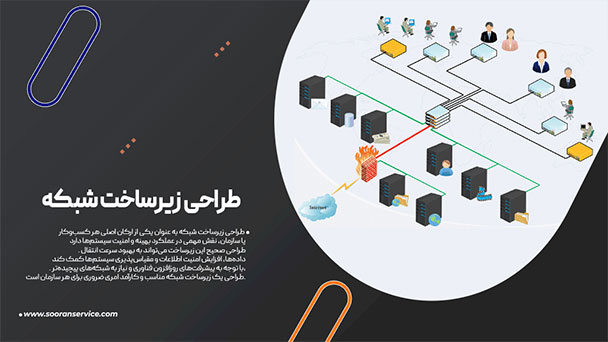Network infrastructure design is one of the core foundations of every business or organization. It plays a vital role in optimizing performance and ensuring the security of systems.
A well-designed infrastructure can improve data transmission speed, enhance information security, and ensure system scalability.
With the rapid advancement of technology and the growing need for complex networks, designing an efficient and reliable infrastructure has become essential for any modern organization.
If you are looking for professional and comprehensive solutions for designing and implementing your organization’s network infrastructure, Sooran Service Noyan is ready to assist you.
This article explores the key stages of network infrastructure design, its importance, and the critical elements required to build a secure and efficient network.
Main Stages of Network Infrastructure Design
Designing a network infrastructure is a complex process that requires careful planning and consideration of all organizational needs.
Below are the essential stages that form the foundation of a secure, scalable, and efficient network.
1. Needs and Objectives Analysis
The first step is analyzing your organization’s requirements and objectives.
This involves defining what services your network should provide and which features are most important — such as high bandwidth, strong security, or flexibility for growth.
2. Equipment and Technology Selection
After defining requirements, the next step is choosing the right equipment and technologies.
This includes selecting servers, switches, routers, firewalls, and related components.
Proper equipment selection directly impacts the performance, reliability, and scalability of your network.
3. Network Topology Design
Network topology defines how all devices and components are connected.
Topologies such as star, mesh, or tree each have their own advantages and applications.
This stage determines how data flows within the network to ensure optimal communication and efficiency.
4. Network Security
Security is a critical part of any infrastructure design.
During this stage, solutions such as firewalls, VPNs, and data encryption are implemented to protect against cyber threats and prevent unauthorized access.
5. Scalability and Future Planning
A modern network must be scalable.
Proper design ensures the network can easily expand as your business grows — supporting new users, devices, and technologies without performance loss.
6. Implementation and Testing
After completing the design, the network is deployed and tested.
Testing ensures all components function properly under different loads and helps identify any weaknesses before full operation.
7. Maintenance and Support
Once implemented, ongoing maintenance and monitoring are crucial.
Regular updates, security patches, and performance reviews help prevent issues and keep the network operating smoothly.

Why Network Infrastructure Design Matters
A well-designed network infrastructure is one of the core foundations of any modern business or organization operating in today’s digital world.
Up-to-date and efficient networks not only improve business performance but also play a vital role in information security and organizational scalability.
In this section, we’ll explore why proper network design is essential and why every business should take it seriously.
1. Improved Network Performance and Speed
A properly designed network delivers optimized performance and efficiently manages different types of traffic.
Poor network design, on the other hand, can cause data transfer delays, unnecessary congestion, and overall system slowdowns.
Through precise planning and design, bandwidth can be utilized effectively to maximize data transfer speeds — a crucial factor for organizations handling large volumes of data or real-time communications.
2. Data Security and Cyberattack Prevention
Network security has become one of the most critical aspects of infrastructure design.
A network that is not built with security in mind can easily become vulnerable to cyberattacks.
To mitigate this risk, security measures such as firewalls, data encryption, and VPNs must be incorporated from the very beginning.
Proper design not only prevents potential security breaches but also protects sensitive organizational data from external threats.
3. Scalability and Business Growth
Another key reason for proper network infrastructure design is scalability.
As organizations grow, their networks must grow with them.
A scalable design ensures the infrastructure can easily expand to accommodate more users, devices, and new technologies — without major disruptions.
This flexibility allows businesses to evolve confidently and respond to future demands with minimal effort.
4. Cost Reduction and Resource Efficiency
An optimized network infrastructure helps organizations avoid unnecessary expenses.
Thoughtful design reduces the need for frequent upgrades and minimizes hardware replacement costs.
A well-structured network maximizes the use of existing resources, prevents waste, and lowers long-term operational and maintenance costs.
5. Optimized Use of Technological Resources
A strong network design enables better utilization of IT resources such as servers, cloud storage, and networking devices.
When systems are properly designed, equipment operates more efficiently, reducing load on resources and improving overall system performance.
This leads to higher productivity and better return on investment across the organization.
6. Reliability and Fault Tolerance
One of the greatest advantages of a well-designed network is its stability and resilience.
By implementing redundant systems and backup mechanisms, organizations can minimize downtime and prevent workflow interruptions.
A properly designed network includes disaster recovery plans and redundancy models that allow operations to continue seamlessly during unexpected failures.
Common Challenges in Network Infrastructure Design
Designing a robust network infrastructure is not without challenges.
It requires careful management, technical expertise, and attention to detail — especially in today’s fast-evolving technology landscape.
Below are some of the most common challenges faced during the design process.
1. Network Security Risks
With the rise of cyberattacks, protecting organizational data has become increasingly complex.
Networks that lack built-in security measures are vulnerable to threats such as DDoS attacks, malware, and unauthorized access.
To prevent these risks, implementing firewalls, data encryption, VPNs, and intrusion detection systems (IDS) is essential.
A secure network design ensures data integrity and system protection at all times.
2. Scalability Limitations
Many networks fail to support future growth because scalability wasn’t considered during the design phase.
As user numbers and data volumes increase, these networks struggle to maintain performance.
To avoid this, the design must include scalable technologies and modular architecture that can easily adapt to organizational expansion.
3. Budget and Resource Constraints
Building a strong and modern network infrastructure often requires significant investment.
Smaller or growing organizations may find it difficult to allocate sufficient funds for advanced equipment.
In such cases, smart prioritization and the use of cloud or virtualized technologies can help reduce costs and provide affordable yet efficient solutions.
4. Integration with Existing Systems
Most organizations already have some level of existing infrastructure before introducing new systems.
Integrating old and new technologies can cause compatibility issues, such as mismatched protocols or configuration conflicts.
Using gateways and protocol controllers can help ensure seamless integration and maintain system harmony.
5. Network Stability and Uptime
Unstructured or poorly planned networks are prone to failures and disruptions.
To achieve continuous uptime, designers must incorporate redundancy and failover mechanisms that keep systems running even in the event of hardware or connection failures.
6. Managing Technical Complexity
Technology evolves rapidly, and networks designed today may become outdated in just a few years.
To counter this, IT teams must stay updated on the latest technologies and continuously optimize their systems.
Flexibility and adaptability should be built into the network architecture to ensure it can evolve with changing technological trends.
7. Anticipating Future Needs
Organizations’ needs inevitably change over time.
A forward-looking network design accounts for potential growth, innovation, and new business requirements.
By planning for scalability and supporting emerging technologies, organizations can ensure their networks remain capable, modern, and reliable in the long run.
Managing Technical Complexity and Future Adaptability
One of the ongoing challenges in network infrastructure design is managing technical complexity.
With new technologies emerging almost daily, a network designed today can quickly become outdated.
To overcome this, IT teams must stay informed about the latest advancements and continuously update and optimize the network.
A well-designed infrastructure should be flexible and adaptable, capable of evolving alongside rapid technological changes.
Another major challenge lies in anticipating future needs and organizational growth.
As business requirements evolve, networks must be designed with adaptability in mind — able to integrate new systems, support innovation, and handle increasing demands.
By prioritizing scalability and technological innovation during the early stages of design, organizations can ensure their network remains resilient, efficient, and ready for future expansion.




No comments yet.